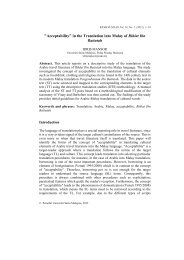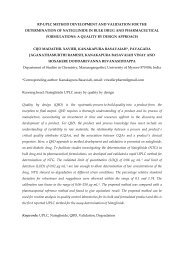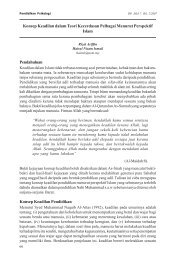Isolation, Identification and Molecular Characterization of Rare - USM
Isolation, Identification and Molecular Characterization of Rare - USM
Isolation, Identification and Molecular Characterization of Rare - USM
You also want an ePaper? Increase the reach of your titles
YUMPU automatically turns print PDFs into web optimized ePapers that Google loves.
Mal. J. Microbiol. Vol 8(2) 2012, pp. 83-91<br />
Table 3: Utilization <strong>of</strong> the carbon sources. Excellent<br />
(+++), Moderate (++), Poor (-)<br />
Utilization <strong>of</strong> Carbon Sources<br />
1 Lactose ++<br />
2 Maltose ++<br />
3 Xylose -<br />
4 Sucrose ++<br />
5 Arabinose -<br />
6 D-Glucose +++<br />
7 Galactose ++<br />
8 Fructose ++<br />
9 Starch +<br />
10 Mannitol -<br />
Table 4: Antibiotic susceptibility testing <strong>of</strong> VUK-10<br />
Susceptibility to Antibiotics: (µg/disc)<br />
1 Nalidixic acid (30)<br />
2 Streptomycin (10)<br />
3 Penicillin (10)<br />
4 Chloramphenicol (30)<br />
5 Rifampicin S<br />
6 Oxy tetracyclin S<br />
Table 5: Antimicrobial Activity <strong>of</strong> Pseudonocardia sp.<br />
VUK-10<br />
S.N Test organism Diameter <strong>of</strong> Clear<br />
o<br />
zone<br />
1 Staphylococcus aureus<br />
MTCC 3160<br />
13<br />
2 Streptococcus mutans<br />
MTCC 497<br />
15<br />
3 Bacillus subtilis ATCC<br />
6633<br />
12<br />
4 E.coli ATCC 35218 11<br />
5 Enterococcus faecalis<br />
MTCC 439<br />
13<br />
6 Pseudomonas<br />
aeruginosa ATCC 9027<br />
15<br />
7 C<strong>and</strong>ida albicans ATCC<br />
10231<br />
10<br />
8 Fusarium oxysporum<br />
MTCC 3075<br />
7<br />
9 Aspergillus niger 9<br />
sequences <strong>of</strong> the close representative strains <strong>of</strong><br />
Pseudonocardia from the GenBank database showed that<br />
this strain formed a close distinct phyletic line with clade<br />
encompassed by Pseudonocardia endophytica,<br />
Pseudonocardia ammonioxdans <strong>and</strong> Pseudonocardia<br />
kongjuensis (fig. 1). Differential characteristics <strong>of</strong> strain<br />
VUK-10 <strong>and</strong> type strains <strong>of</strong> closely related<br />
Pseudonocardia sp. are represented in Table 2.<br />
R<br />
S<br />
R<br />
S<br />
Based on the morphological, cultural, physiological,<br />
biochemical <strong>and</strong> molecular characteristics the strain has<br />
been included under the genus Pseudonocardia <strong>and</strong><br />
deposited at NCBI genbank with an accession number<br />
JN087501.<br />
Antimicrobial spectrum <strong>of</strong> Pseudonocardia species VUK-<br />
10 is represented in Table 5. The strain inhibited growth<br />
<strong>of</strong> Gram positive <strong>and</strong> Gram negative bacteria, yeast <strong>and</strong><br />
fungi suggesting a broad spectrum nature <strong>of</strong> the active<br />
compound.<br />
A perusal <strong>of</strong> literature indicates the bioactive metabolite<br />
pr<strong>of</strong>ile <strong>of</strong> Pseudonocardia sp. includes antibacterial,<br />
antifungal, enzyme inhibitors, neuro protective <strong>and</strong> anti-<br />
Helicobacter pylori compounds. Rajendra et al. (2003)<br />
isolated a new phenazine derivative, phenazostatin D<br />
from Pseudonocardia sp.B6273, acts as a<br />
neuroprotective. Omura et al. (1979) reported<br />
antimicrobial activity <strong>of</strong> the antibiotics azureomycins A <strong>and</strong><br />
B from Pseudonocardia azurea sp. Dekkar et al. (1998)<br />
extracted new quinolone compounds from<br />
Pseudonocardia sp. with selective <strong>and</strong> potent anti-<br />
Helicobacter pylori activity.<br />
CONCLUSION<br />
The present study is mainly involved in the isolation <strong>and</strong><br />
identification <strong>of</strong> actinomycetes based on the cultural,<br />
morphological physiological, biochemical <strong>and</strong> molecular<br />
characteristics. Further studies on optimization,<br />
purification <strong>and</strong> elucidation <strong>of</strong> chemical structure <strong>of</strong> active<br />
compound are currently in progress. It is expected that the<br />
current attempt for the isolation <strong>and</strong> characterization <strong>of</strong><br />
actinobacteria from Nizampatnam mangrove ecosystem<br />
will be useful for the identification <strong>of</strong> novel antibiotics<br />
effective against various pathogens.<br />
ACKNOWLEDGEMENTS<br />
Authors (MUK <strong>and</strong> MVL) are thankful to the council <strong>of</strong><br />
scientific <strong>and</strong> industrial research for providing financial<br />
support to carry out this study.<br />
REFERENCES<br />
Alongi, D. M. (2002). Present state <strong>and</strong> future <strong>of</strong> the<br />
world’s mangrove forests. Environmental Conservation<br />
29, 331-349.<br />
Atta, H. M., Dabour, S. M. <strong>and</strong> Desoket, S. G. (2009).<br />
Saprosomycin antibiotic production by Streptomyces<br />
sp AZ-NIOFD1: Taxonomy, Frementation, Purification<br />
<strong>and</strong> Biological Activities, American Eurasian, Journal<br />
<strong>of</strong> Agriculture <strong>and</strong> Environmental Sciences 5, 368-<br />
377.<br />
Baltz, R. H. (2008). Renaissance in antibacterial<br />
discovery from actinomycetes. Current Opinion in<br />
Pharmacology 8, 1-7.<br />
Baskaran, R. Vijayakumar, R. <strong>and</strong> Mohan, P. M. (2011).<br />
89 ISSN (print): 1823-8262, ISSN (online): 2231-7538




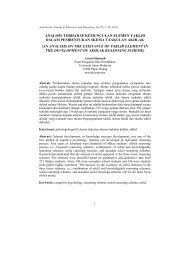
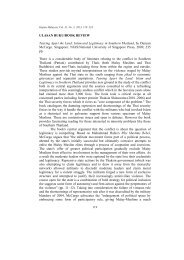

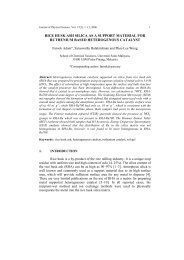

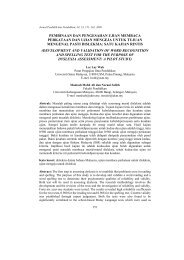
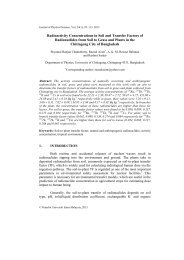
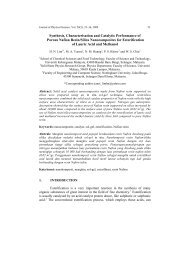

![KTT 111 – Inorganic Chemistry I [Kimia Takorganik I] - USM](https://img.yumpu.com/12405642/1/184x260/ktt-111-inorganic-chemistry-i-kimia-takorganik-i-usm.jpg?quality=85)
